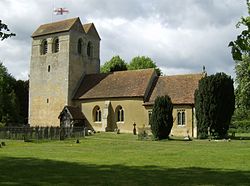Fingest
| Fingest | |
| Buckinghamshire | |
|---|---|
 St Bartholomew’s Church | |
| Location | |
| Grid reference: | SU777912 |
| Location: | 51°36’51"N, -0°52’37"W |
| Data | |
| Post town: | Henley-on-Thames |
| Postcode: | RG9 |
| Dialling code: | 01491 |
| Local Government | |
| Council: | Buckinghamshire |
| Parliamentary constituency: |
Wycombe |
Fingest is a village and ancient parish in the Desborough Hundred of Buckinghamshire. It is in the Chiltern Hills adjacent to the border with Oxfordshire. It is about six miles west-south-west of High Wycombe. It lies in the civil parish of Hambleden.
Toponymy
The village name of Fingest comes from the Anglo-Saxon name Thinghurst, meaning 'wooded hill where assemblies are made'. In the 16th century the name is recorded as Thingest and then Fingest.[1] Although the early name is the etymological root of both 'Tinghurst' and 'Fingest', the latter doesn't follow the former by any normal linguistic line.
History
The ancient parish of Fingest includes the Buckinghamshire part of Cadmore End to the north of the village, which became a separate ecclesiastical parish in 1852.[2]
The manor of Fingest anciently belonged to St Albans Abbey. In 1163 it was given to the bishop of Lincoln. The ghost of Henry Burghersh, 14th-century Bishop of Lincoln, is reputed to haunt the area.[3] After this time it was used as the country residence for the Lincoln diocese until 1547 when it was seized by the Crown. It was then given two years later to the Duke of Somerset who exchanged it with a property belonging to Wells Cathedral.[2] The manor is now privately owned.
The civil parish of Fingest, originally based on the ancient parish, was enlarged in 1934 by adding land from neighbouring West Wycombe, Great Marlow and Hambleden. As a result, Lane End became the largest settlement in the parish, and it was renamed Fingest and Lane End in 1937. In the 1980s the civil parish was abolished. The larger part became the civil parish of Lane End, and the village of Fingest was added to Hambleden.
Scenes of the period drama The Monuments Men were shot in Fingest in May 2013, starring George Clooney, Matt Damon and Jean Dujardin.[4]
Church
The parish church of St Bartholomew's dates from the early Norman period. It has an unusual tower, with a double vaulted roof. The church is a Grade-I listed building.[5]
References
| ("Wikimedia Commons" has material about Fingest) |
- ↑ Watts, Victor, ed. (2010), "Fingest", The Cambridge Dictionary of English Place-Names, Cambridge University Press
- ↑ Jump up to: 2.0 2.1 William Page, ed (1925). "Parishes: Fingest". A History of the County of Buckingham: Volume 3. Institute of Historical Research. http://www.british-history.ac.uk/report.aspx?compid=42526. Retrieved 11 July 2011.
- ↑ "Green Man of Fingest - Mysterious Britain & Ireland". Mysterious Britain & Ireland. Archived from the original on 12 December 2010. https://web.archive.org/web/20101212234121/http://www.mysteriousbritain.co.uk/england/buckinghamshire/hauntings/green-man-of-fingest.html. Retrieved 29 August 2014.
- ↑ [1] Period Drama filmed in Fingest.
- ↑ English Heritage: Images of England